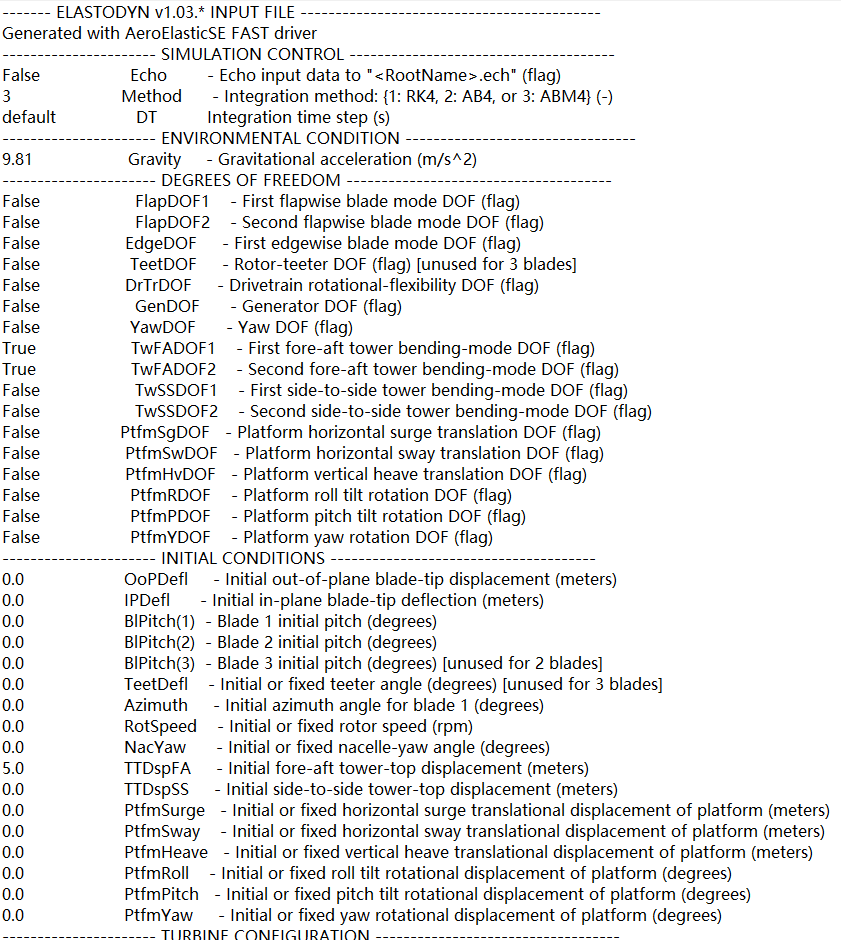Hi everyone.
Recently, I am using FAST V8 to analyze the frequency response of a fixed offshore wind turbine. I found that there is a response peak of 0.15hz in the motion of the tower base when I set a no wind-wave condition. I want to know what caused this frequency response around the 0.15hz? (The 1P is 0.14hz, and the first-order natural frequency of the tower base is about 0.3hz).
Much thanks!

Dear @Chenzi.Yang,
The response peaks are typically found at excitation frequencies (harmonics of the rotor speed, peak wave frequency) and full-system natural frequencies. The excitation frequencies can be identified by the resulting rotor speed and wave input (WaveTp). The full-system natural frequencies can be identified through a linearization and subsequent eigenanalysis.
Best regards,
Dear Jason,
Many thanks for your response. In the case shown in the last figure, there exist no excitation frequencies due to the environment set of still wind and still water, and the rotor speed is 0. Can I regard that the frequency response peak (0.15Hz) in the tower base fore-after moment originated from the system’s natural frequency? However, through the free decay analysis, I found that the natural frequency of 1st Tower Fore-Aft is 0.3hz, which is far away from the peak frequency 0.15Hz. This result confuses me. Is it possible that this peak frequency 0.15Hz is caused by the dynamic response of the monopile foundation? How can I get the natural frequency of a monopile-like supported structure?
Best regards,
Dear @Chenzi.Yang,
Presumably your structural model uses a combination of ElastoDyn down to the transition piece and SubDyn between the transition piece and foundation; is that correct? It is not possible to linearize a model with SubDyn enabled in FAST v8, but this is possible in OpenFAST. Linearization followed by eigenanalysis is the most straightforward way of identifying the full-system natural frequencies. So, upgrading your model to OpenFAST may be best.
Otherwise, you can identify full-system natural frequencies through free-decay analyses. You didn’t mention how you performed a decay test, but presumably you gave an initial tower deflection and tracked the time-series response. I would expect multiple modes of the support structure would get initialized by this method that you could identify by computing the PSD of the time series of deflections and/or loads at nodes along the support structure. What do you see when you do this?
Best regards,
Dear Jason,
Many thanks for your reply.
The initial tower deflection can be set with ElastDyn (as shown in the picture below) when using the free decay analysis.
However, for the support structure, I don’t know where I can initial its deflection. Could you please give me some pointers?
Best regards.
Dear @Chenzi.Yang,
The initial conditions you highlight will initialize the tower mode modes in ElastoDyn. The initial conditions for the platform just below that in the ElastoDyn input file will initialize the Guyan modes within SubDyn (that are solved through the platform DOFs of ElastoDyn). SubDyn does not currently support nonzero initialization of the Craig-Bampton modes. In reality, the full-system modes of the support structure will include a combination of ElastoDyn tower, ElastoDyn platform DOFs/SubDyn Guyan modes, and SubDyn Craig-Bampton modes. So, it would be very difficult to initialize the first support structure mode purely, and in reality, no matter what initial conditions you set, you will initialize several modes of the support structure.
Best regards,
Dear Jason,
Thanks for your reply. Through my test, I found that tower natural frequency shaft is caused by the flexibility of supporting structures, which settles my confusion.
But with free-decay modal analysis of monopile foundation tower, I found that there only exists the 1st natural frequency peak and the 2nd natural frequency response can’t be observed in FFT figure. What may cause such a phenomenon?

(ElastDyn file is set as follows when employing free-decay analysis)
Best regards,
Dear @Chenzi.Yang,
The tower deflection initial conditions set within ElastoDyn will be applied only to the first tower bending mode degrees of freedom. So, the second mode is not being excited in this case.
Best regards,



